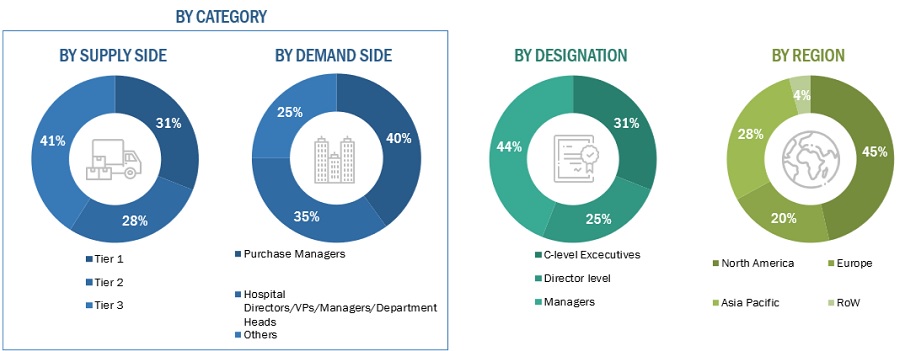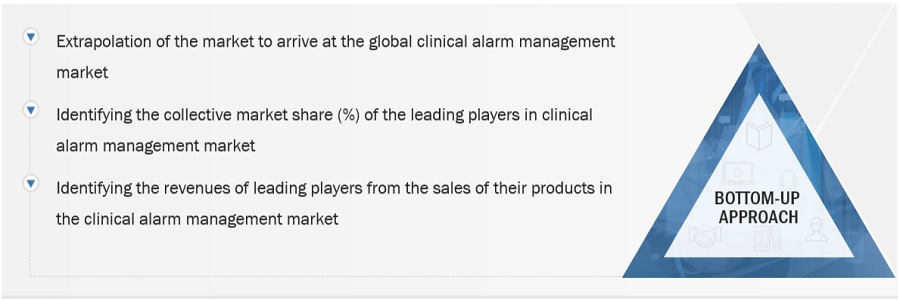This market research study involved the extensive use of secondary sources, directories, and databases to identify and collect information useful for this technical, market-oriented, and financial study of the clinical alarm management market. In-depth interviews were conducted with various primary respondents, including key industry participants, subject-matter experts (SMEs), C-level executives of key market players, and industry consultants, among other experts, to obtain and verify critical qualitative and quantitative information and to assess market prospects. The size of the clinical alarm management market was estimated through various secondary research approaches and triangulated with inputs from primary research to arrive at the final market size.
Secondary Research
The secondary research process involved the widespread use of secondary sources, directories, databases (such as Bloomberg Businessweek, Factiva, and D&B Hoovers), white papers, annual reports, company house documents, investor presentations, and SEC filings of companies. Some non-exclusive secondary sources include the Association for the Advancement of Medical Instrumentation (AAMI), the American Association of Critical-Care Nurses (AACN), the World Health Organization (WHO), the Organisation for Economic Co-operation and Development (OECD), Healthcare Information and Management Systems Society (HIMSS), European Federation for Medical Informatics (EFMI), Expert Interviews, and MarketsandMarkets Analysis.
Secondary research was used to identify and collect information useful for the extensive, technical, market-oriented, and commercial study of the clinical decision support system market. It was also used to obtain important information about the key players and market classification and segmentation according to industry trends to the bottom-most level and key developments related to market and technology perspectives. A database of the key industry leaders was also prepared using secondary research.
Primary Research
Extensive primary research was conducted after acquiring basic knowledge about the global Clinical alarm management market scenario through secondary research. Several primary interviews were conducted with market experts from both the demand side (Hospital directors, Hospital Vice Presidents, Department heads, and Critical care specialists ) and supply side (such as C-level and D-level executives, technology experts, product managers, marketing and sales managers, among others) across five major regions—North America, Europe, the Asia Pacific, Latin America, Middle East, and Africa. This primary data was collected through questionnaires, e-mails, online surveys, personal interviews, and telephonic interviews.
Breakdown of Primary Interviews

Note 1: Tiers are defined based on the total revenues of companies. As of 2022, Tier 1 = >USD 1 billion, Tier 2 = USD 500 million to USD 1 billion, and Tier 3 = <USD 500 million.
To know about the assumptions considered for the study, download the pdf brochure
Market Size Estimation
Both top-down and bottom-up approaches were used to estimate and validate the total size of the global Clinical alarm management market. These methods were also used extensively to estimate the size of various subsegments in the market. The research methodology used to estimate the market size includes the following:
-
Key players in the global clinical alarm management market were identified through secondary research, and their global market shares were determined through primary and secondary research
-
The research methodology included the study of the annual and quarterly financial reports and regulatory filings, data books of major market players, and interviews with industry experts for detailed market insights.
-
All percentage shares, splits, and breakdowns for the global clinical alarm management market were determined by using secondary sources and verified through primary sources.
-
All key macro indicators affecting the revenue growth of market segments and subsegments have been accounted for, viewed in extensive detail, verified through primary research, and analyzed to get validated and verified quantitative and qualitative data.
-
The gathered market data was consolidated and added with detailed inputs and analysis and presented in this report.
Global Clinical Alarm Management Market: Bottom-Up Approach

To know about the assumptions considered for the study, Request for Free Sample Report
Global Clinical Alarm Management Market: Top-Down Approach

Data Triangulation
After arriving at the overall market size, from the market size estimation process explained above, the clinical alarm management market was split into segments and subsegments. To complete the overall market engineering process and to arrive at the exact statistics for all segments and subsegments, data triangulation and market breakdown procedures were employed, wherever applicable. The data was triangulated by studying various factors and trends from both the demand and supply sides in the clinical alarm management market.
Market Definition:
Clinical alarms refer to audible, visual, or tactile alerts generated by medical devices, monitoring systems, or healthcare equipment to notify healthcare providers or other relevant personnel about specific events or changes in a patient's condition. These alarms are designed to draw attention to situations that require prompt action or intervention.
Clinical alarms are crucial in healthcare settings by providing timely notifications of critical events, helping healthcare professionals monitor patients, and responding quickly to potential issues. Examples of clinical alarms include alerts related to abnormal vital signs, equipment malfunctions, or other conditions that may require immediate attention. They provide essential warnings to alert caregivers of changes in patient conditions. Alarm fatigue is a sensory overload that occurs when clinicians are exposed to excessive alarms, resulting in desensitization to alarms and missed alarms, adversely impacting patient safety and leading to life-threatening events.
Clinical alarm management is a safety initiative for healthcare providers that is critical for patient safety, essential for staff satisfaction, and mandated by regulatory agencies.
Key Stakeholders:
-
Clinical Alarm Management Vendors
-
Medical Device Manufacturers
-
Alarm System Developers
-
Technology Companies
-
Government Bodies/Municipal Corporations
-
Regulatory Bodies
-
Healthcare Service Providers
-
Clinical/Physician Centers
-
Healthcare Professionals
-
Health It Providers
-
Healthcare Associations/Institutes
-
Assisted Living Centers/Nursing Homes
-
Ambulatory Care Centers
-
Venture Capitalists
-
Distributors And Resellers
-
Maintenance And Support Service Providers
-
Integration Service Providers
-
Healthcare Payers
-
Advocacy Groups
-
Data Security And Privacy Experts
-
Standards And Certification Organizations
-
Investors And Financial Institutions
-
Researchers And Academia
-
Industry Associations And Trade Groups
-
Consultancy Firms
-
Market Analysts And Research Firms
Report Objectives
-
To define, describe, and forecast the global Clinical alarm management market based on component, product, type, deployment mode, end user, and region.
-
To provide detailed information regarding the major factors (such as drivers, restraints, opportunities, and challenges) influencing the market growth
-
To strategically analyze micro-markets with respect to individual growth trends, prospects, and contributions to the overall clinical alarm management market
-
To analyze opportunities in the market for stakeholders and provide details of the competitive landscape for market leaders.
-
To strategically analyze the market structure profile the key players of the clinical alarm management market and comprehensively analyze their core competencies.
-
To forecast the size of the market segments with respect to five regions, namely, North America, Europe, Asia Pacific, South America, and the Middle East & Africa.
-
To track and analyze competitive developments such as product launches and enhancements and investments, partnerships, collaborations, acquisitions, expansions, agreements, sales contracts, and alliances in the clinical alarm management market during the forecast period.
Available Customizations:
With the given market data, MarketsandMarkets offers customizations as per the company’s specific needs. The following customization options are available for the report:
Geographic Analysis
-
Further breakdown of the Rest of the Asia Pacific market into Singapore, Malaysia, Thailand, and Australia, and others
-
Further breakdown of the Rest of Europe market into Russia, Denmark, Sweden, Finland, and other European countries



Growth opportunities and latent adjacency in Clinical Alarm Management Market